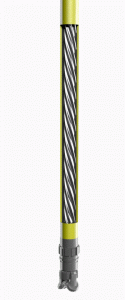A mud motor (or drilling motor) is a progressive cavity positive displacement pump (PCPD) placed in the drill string to provide additional power to the bit while drilling. The PCPD pump uses drilling fluid (commonly referred to as drilling mud, or just mud) to create eccentric motion in the power section of the motor which is transferred as concentric power to the drill bit. The mud motor uses different rotor and stator configurations to provide optimum performance for the desired drilling operation, typically increasing the number of lobes and length of power assembly for greater horsepower. In certain applications, compressed air, or other gas, can be used for mud motor input power. Normal rotation of the bit while using a mud motor can be from 60 rpm to over 100 rpm.
Basic principle
A helical rotor with one or more lobes will rotate eccentrically when the stator contains more lobes than the rotor. The flow of the fluid transmits power allowing the assembly to rotate and turn the bit.
Normal construction/Usage
Normal mud motor construction consists of a top sub, which connects the mud motor to the drill string; the power section, which consists of the rotor and stator; the transmission section, where the eccentric power from the rotor is transmitted as concentric power to the bit using a constant-velocity joint; the bearing assembly which protects the tool from off bottom and on bottom pressures; and the bottom sub which connects the mud motor to the bit.
When the bit is bottomed and the motor is effectively working, there is a notable increase in the pressure in the fluid system. This is caused by a restriction within the motor and is termed the “differential pressure”. If this differential pressure is too high then the motor can stall which means the bit has stopped turning and this can cause severe damage to the internal surface of the stator.
A mud motor is described in terms of its number of stages, lobe ratio and external diameter. Stages are the number of full twists that the stator makes from one end to the other and the lobe ratio is the number of lobes on the stator, to the number of lobes on the rotor (the stator always has one more lobe than the rotor). A higher number of stages indicates a more powerful motor. A higher number of lobes indicates a higher torque output (for a given differential pressure), a lower number of lobes indicates a reduction in the torque produced but a faster bit rotation speed.
The operating parameters include flow rate, bit rpm and torque. The relationship between the rotor and the stator geometry determines the rotational speed and torque. The rotational speed is proportional to the flow rate and torque is proportional to the pressure drop in the fluid as it flows through the motor. The more lobes the higher the torque and the slower the rpm.
The use of mud motors is greatly dependent on financial efficiency. In straight vertical holes, the mud motor may be used solely for increased rate of penetration (ROP), or to minimize erosion and wear on the drill string, since the drill string does not need to be turned as fast.
The majority of mud motor use is in the drilling of directional holes. Although other methods may be used to steer the bit to the desired target zone, they are more time-consuming, which adds to the cost of the well. Mud motors can be configured to have a bend in them using different settings on the motor itself. Typical mud motors can be modified from 0 degrees to 3 degrees with approximately six increments in deviation per degree of bend. The amount of bend is determined by rate of climb needed to reach the target zone. By using a measurement while drilling (MWD) tool, a directional driller can steer the bit to the desired target zone.
Steerable motors are used to drill the kick-off point. When drilling the kick-off point be sure to avoid drilling a soft formation immediately below a hard one. In hard abrasive formations the high-side forces at kick off can cause severe bit shank wear. Ideally the kick-off point should be selected in a non-abrasive homogenous formation.
Advantages
Extremely hard rock formations can be drilled with motors using diamond or polycrystalline diamond compact (PDC) bits.
High penetration rates can be achieved since rotation speeds are high.
Will allow circulation of the borehole regardless of the horsepower or torque produced by the motor.
Post time: Apr-07-2021







